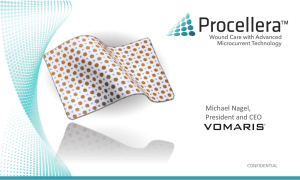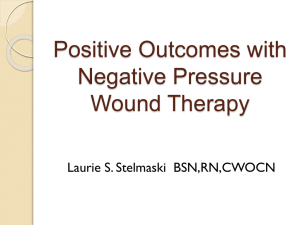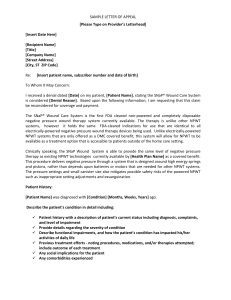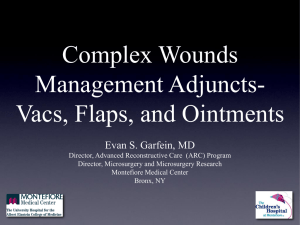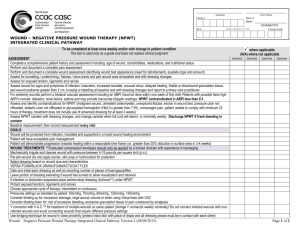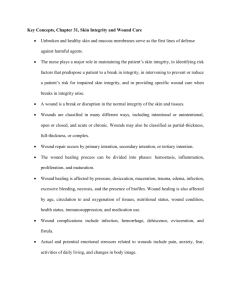Protocol for the use of Negative Pressure Wound Therapy (NPWT)
advertisement
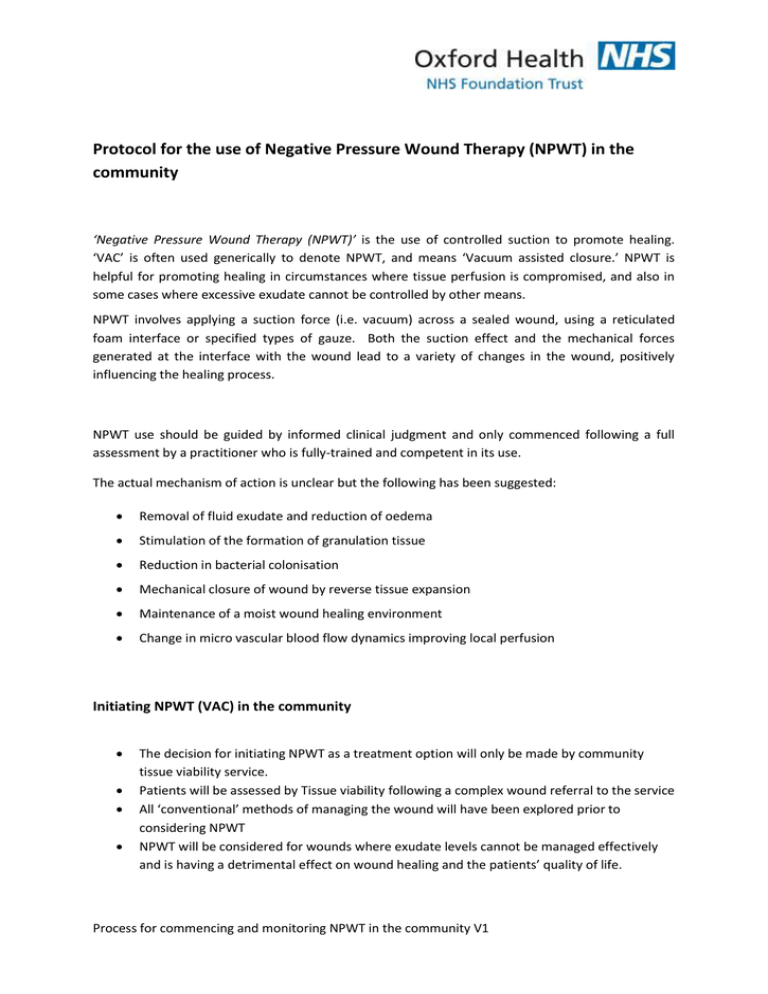
Protocol for the use of Negative Pressure Wound Therapy (NPWT) in the community ‘Negative Pressure Wound Therapy (NPWT)’ is the use of controlled suction to promote healing. ‘VAC’ is often used generically to denote NPWT, and means ‘Vacuum assisted closure.’ NPWT is helpful for promoting healing in circumstances where tissue perfusion is compromised, and also in some cases where excessive exudate cannot be controlled by other means. NPWT involves applying a suction force (i.e. vacuum) across a sealed wound, using a reticulated foam interface or specified types of gauze. Both the suction effect and the mechanical forces generated at the interface with the wound lead to a variety of changes in the wound, positively influencing the healing process. NPWT use should be guided by informed clinical judgment and only commenced following a full assessment by a practitioner who is fully-trained and competent in its use. The actual mechanism of action is unclear but the following has been suggested: Removal of fluid exudate and reduction of oedema Stimulation of the formation of granulation tissue Reduction in bacterial colonisation Mechanical closure of wound by reverse tissue expansion Maintenance of a moist wound healing environment Change in micro vascular blood flow dynamics improving local perfusion Initiating NPWT (VAC) in the community The decision for initiating NPWT as a treatment option will only be made by community tissue viability service. Patients will be assessed by Tissue viability following a complex wound referral to the service All ‘conventional’ methods of managing the wound will have been explored prior to considering NPWT NPWT will be considered for wounds where exudate levels cannot be managed effectively and is having a detrimental effect on wound healing and the patients’ quality of life. Process for commencing and monitoring NPWT in the community V1 NPWT will be considered for full thickness wounds which are failing to granulate due to poor tissue perfusion. Inclusion - Wound types Category 3 & 4 pressure ulcers Dehisced surgical wounds that are failing to progress. NPWT should not be used for any of the following wounds: Unexplored fistulae to organs or body cavities Cavity / sinus of unknown depth or origin Wound with malignancy Necrotic wound with eschar or slough Wound with unstable fractures, or sharp / loose fragments of bone Untreated osteomyelitis Actively bleeding wounds Wounds with open joints Wounds with exposed blood vessels or organs Treatment timescales This will be decided on a case by case basis but is expected to be 2 – 4 weeks. Training All nurses caring for a patient with NPWT (VAC) will receive training and support from KCI. Training manuals will be provided both as a hard copy and electronically to nursing teams. A competency framework is available to assess level of knowledge and skills. Process for commencing and monitoring NPWT (VAC) in the community – Refer to flow diagram, appendix 1 Measuring outcomes NPWT (VAC) activity will be entered on to Oxford Healths electronic patient database (RIO) Tissue viability will keep a database recording wound type, length of treatment and clinical outcome. An annual report will be produced by Tissue Viability to summarise activity, spend and clinical outcomes. Process for commencing and monitoring NPWT in the community V1 Appendix 1. Process for commencing and monitoring Negative Pressure Wound Therapy (NPWT) in the community (Following an assessment by tissue viability) Patient assessed by community tissue viability service following complex wound referral Wound would benefit from NPWT? NO Treat with conventional dressings. YES Tissue Viability to Contact KCI to order Activac pump giving a date for delivery. Tel 0800 980 8880 TV to arrange training for team if this is required. Care plan recommended for ongoing management TV to complete prescription request for consumables (dressings and canisters) and fax to GP - OR Issue consumables from tissue viability stock (for recommended treatment timescale) Treatment commenced Patient details entered to TV databases and RIO Ongoing training and support from KCI and Tissue Viability Tissue viability to cancel ACTIVAC rental with KCI. Pump will be collected by KCI Tissue viability will reassess patient before end of planned treatment time. Ongoing wound management plan to be advised and implemented by community nursing team Process for commencing and monitoring NPWT in the community V1
